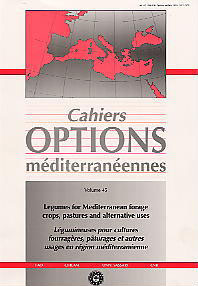| Article précédent | p. 171-175 | Article suivant |
Growth and DM yield of three Lotus spp. (L. corniculatus L., L. glaber Mill. and L. uliginosus Cav.) in clay soils of the Chilean Mediterranean zone
In the seventh and eighth regions of Chile there is an area of clayey soils where national rice production is located. This crop annually uses about a quarter of the land and a high proportion of the available water for irrigation. It has been suggested to use the rest of the land in animal production introducing annual or perennial forage legumes with low irrigation requirements. Among these species, the establishment, growth and DM production of three Lotus species (L. corniculatus (Lc); L. glaber (Lg); and L. uliginosus (Lu)) was studied, because of their nutritive value, N-fixation and condensed tannins concentration, which avoid bloat in ruminants. The low temperatures recorded during the sowing period (autumn-winter) negatively affected the germination rate of Lu more than Lg and Lc. The exclusion of P from a complete formula of fertilizer application produced a significant growth reduction in the early stages of the three species.
- [ Afficher ]
- [ Télécharger ]
- [ Exporter la citation ]
Vous pouvez télécharger la citation au format :
- [ Imprimer ]
-
Mots-clés
CROISSANCE, ETABLISSEMENT DE LA PLANTE, GERMINATION, LOTUS CORNICULATUS, LOTUS ULIGINOSUS, PATURAGES, RENDEMENTCiter cet article
Acuña H. Growth and DM yield of three Lotus spp. (L. corniculatus L., L. glaber Mill. and L. uliginosus Cav.) in clay soils of the Chilean Mediterranean zone. In : Sulas L. (ed.). Legumes for Mediterranean forage crops, pastures and alternative uses . Zaragoza : CIHEAM, 2000. p. 171-175. (Cahiers Options Méditerranéennes; n. 45). 10. Meeting of the Mediterranean Sub-Network of the FAO-CIHEAM Inter-Regional Cooperative Research and Development Network on Pastures and Fodder Crops, 2000/04/04-09, Sassari (Italy). http://om.ciheam.org/om/pdf/c45/00600190.pdf



